Remember when car interiors were more than just black plastic and beige fabric? Back in the groovy decades of the ’60s and ’70s, automakers threw caution to the wind and created some of the most audacious, colorful, and downright wild cabin designs ever to grace four wheels. Sure, some of these combinations sound absolutely bonkers when you describe them today—who thought lime green vinyl and orange shag carpeting was a good idea?—but somehow, they captured the spirit of their times perfectly. These interiors weren’t just transportation; they were rolling statements of personal style, complete with enough personality to make today’s car buyers weep with envy.
1. Plymouth ‘Cuda
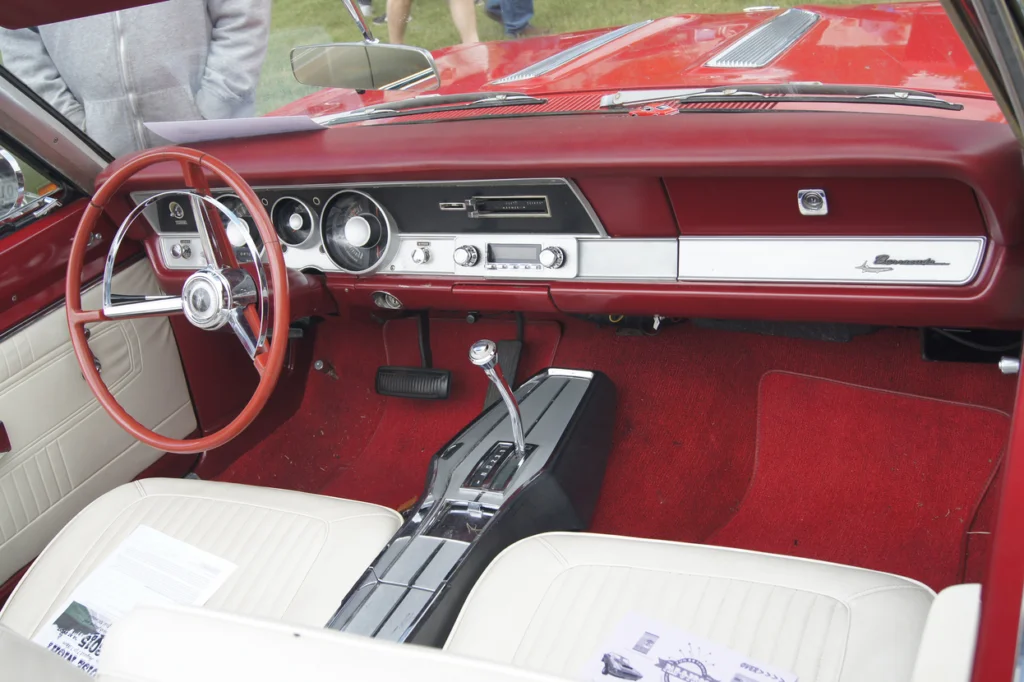
The Plymouth ‘Cuda’s Moulin Rouge package sounds like something you’d find in a Vegas lounge, and honestly, that’s exactly what it looked like. This wild option combined deep burgundy detailing with matching door panels contrasting light seats, creating an interior that was equal parts sophisticated and sinful. The red and white theme extended to the steering wheel, dashboard trim, and even the floor mats, making you feel like you were driving a high-performance bordello on wheels. Trust Auto has more on the energizing history of this stylish vehicle.
What made this combination work was Plymouth’s commitment to the theme—they didn’t half-heartedly splash some red around and call it a day. The rich burgundy wasn’t some cheap-looking maroon; it was a deep, lustrous color that actually complemented the ‘Cuda’s aggressive exterior lines. When you slid behind that wood-grain steering wheel and fired up the 340 or 440 V8, you weren’t just driving a muscle car—you were making an entrance that said you had taste, even if that taste was a little on the wild side.
2. Dodge Charger R/T with White Interior
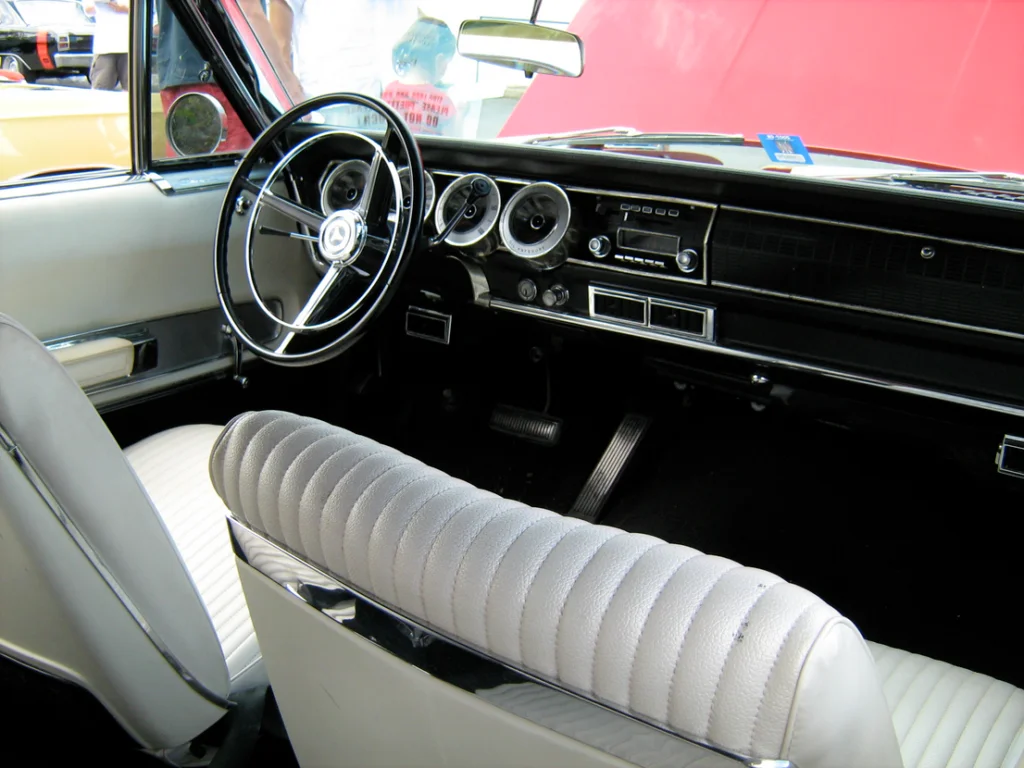
Nothing says “I’m confident in my driving abilities” quite like ordering a 440 Magnum-powered Charger with a pristine white interior. Dodge offered this bold option package that featured white vinyl bucket seats with matching door panels and a white headliner that made the cabin feel like a spaceship from a sci-fi movie. The contrast between the typically dark dash and exterior colors and that brilliant white interior created a visual punch that was impossible to ignore. MotorTrend puts into perspective just how extensive the history of the Dodge Charger is, in full.
The white interior worked because it emphasized the Charger’s futuristic design language—those flowing lines and hidden headlights already looked like something from the year 2000. The bright cabin made the car feel larger and more open, which was quite a feat considering the Charger’s already generous proportions. Sure, keeping it clean was about as practical as wearing white pants to a barbecue, but when you looked that good, who cared about a little maintenance?
3. Ford Mustang Mach 1
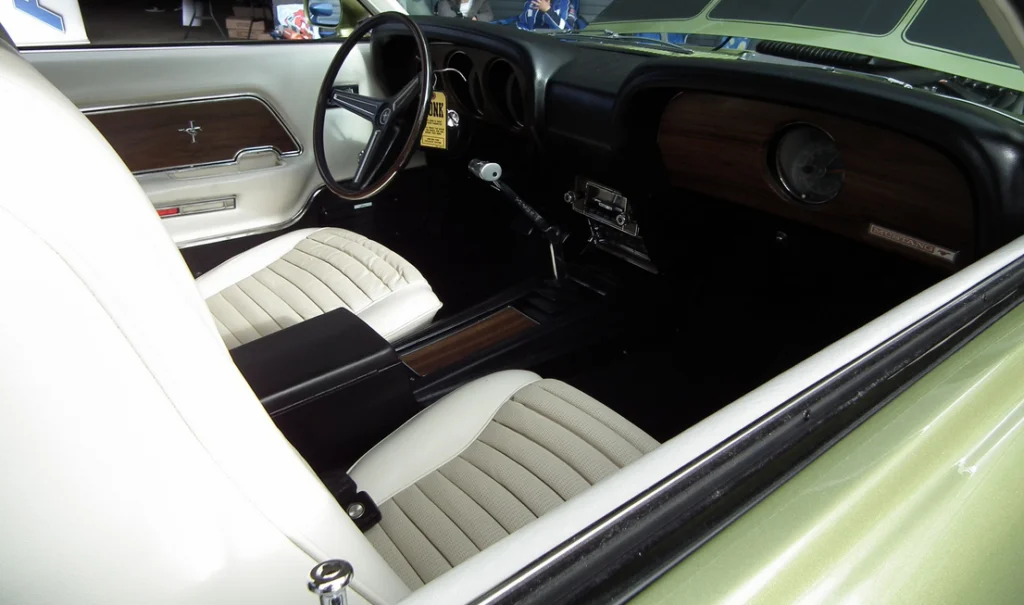
Ford’s Ginger interior option for the Mach 1 was essentially bright neutrals done right—a vibrant shade that somehow managed to be both earthy and electric at the same time. The color covered everything from the high-back bucket seats to the door panels, creating a cohesive environment that felt like the spotlight in a muscle car. Paired with the optional Shaker hood scoop and Competition Suspension, the Ginger interior made every drive feel like a scene from a Steve McQueen movie. Top Speed has traced the revolutionary transformations and changes this car has undergone over the years.
The genius of the Ginger interior was how it complemented rather than competed with the Mach 1’s performance credentials. The warm orange tones actually made the black instrument cluster and steering wheel pop, creating better visibility for the driver during spirited driving. It was bold enough to turn heads at the drive-in but sophisticated enough that you wouldn’t be embarrassed picking up your date’s parents—assuming they had a sense of adventure, of course.
4. Camaro SS with Bright Blue Interior
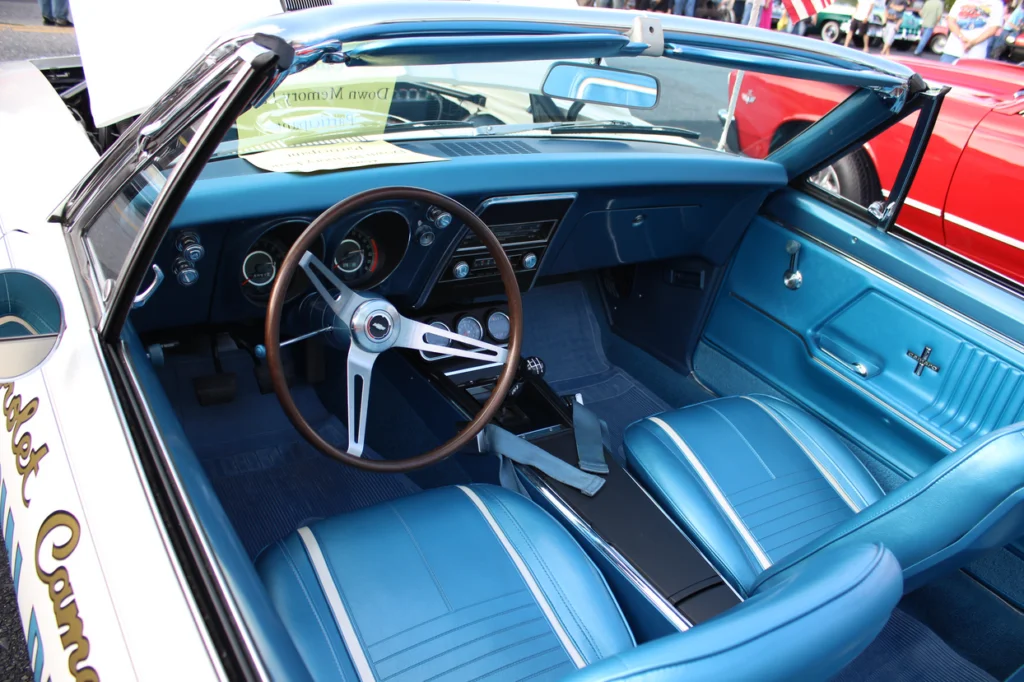
Chevrolet’s Bright Blue interior option for the first-generation Camaro was like wearing your favorite pair of bell-bottoms—it shouldn’t have worked, but it absolutely did. The electric blue vinyl covered the bucket seats, door panels, and even extended to the dashboard pad, creating an interior that looked like it belonged in a cartoon about the future. When paired with rally wheels and the SS badges, it transformed the Camaro from just another pony car into a rolling piece of pop art.
The blue interior succeeded because it captured the optimistic spirit of the late ’60s, when everything seemed possible and subtlety was overrated. The color was bright enough to make you smile every time you got in, but it wasn’t so garish that it hurt your eyes during long drives. Plus, it photographed beautifully, which mattered more than most people admitted back when everyone was trying to look cool at the local cruise night.
5. Chevelle SS with
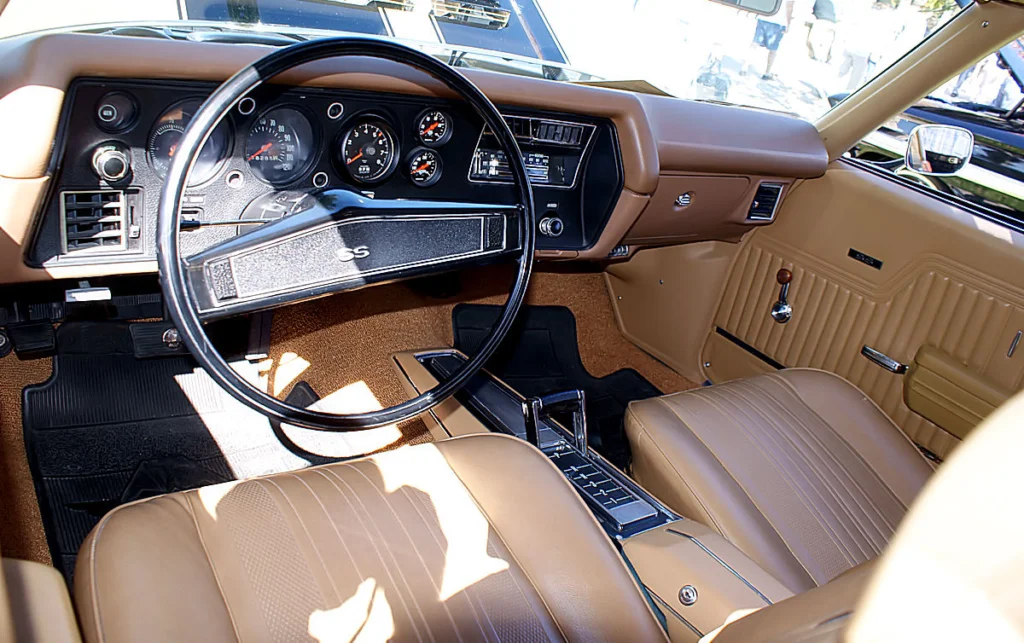
Chevrolet’s Medium Green interior option for the Chevelle SS proved that even muscle cars could have an earthy side. This wasn’t some sickly dirt brown—it was a rich, lively shade that covered the bucket seats and door panels with a sophistication that belied the car’s street-fighting credentials. The tan theme extended to beneath the dashboard pad and steering wheel, creating a cohesive environment that felt more like a gentleman’s club than a drag strip warrior.
The creamy tan interior worked because it offered a refreshing alternative to the usual black, white, and red options that dominated muscle car showrooms. It was different enough to start conversations but tasteful enough that you wouldn’t get tired of it after the novelty wore off. When you combined it with the Chevelle’s clean body lines and that throaty 454 big block, you had a car that could run with the best of them while looking like it belonged in a higher tax bracket.
6. Firebird Trans Am
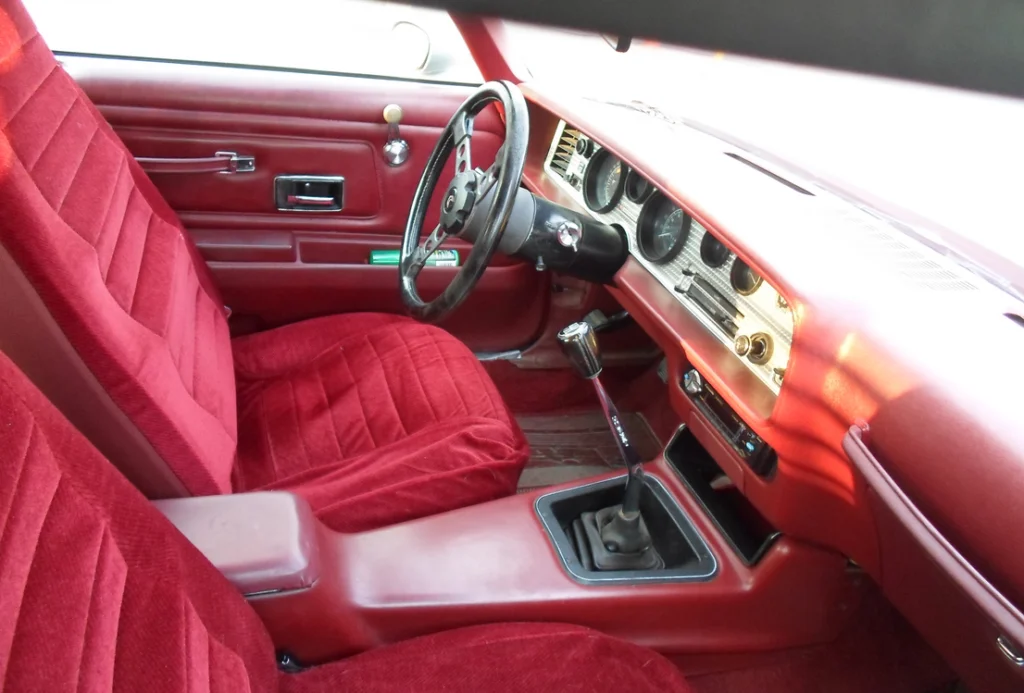
Pontiac’s red interior option for the Trans Am was like ordering a fine wine with your burger—unexpected, but somehow perfect. This creamy crimson color scheme covered the bucket seats, door panels, and dashboard, creating an interior that looked more like a luxury car than a track-focused performance machine. The light color made the cabin feel larger and more open, which was a nice touch in a car that was all about making statements.
The Parchment interior succeeded because it showed that performance cars didn’t have to look like race cars inside. The sophisticated color scheme actually made the Trans Am’s functional elements—like the Rally gauges and three-spoke steering wheel—stand out more prominently. It was the automotive equivalent of wearing a perfectly tailored suit to a motorcycle rally: completely unexpected, but undeniably classy.
7. Challenger with Suble Detailing
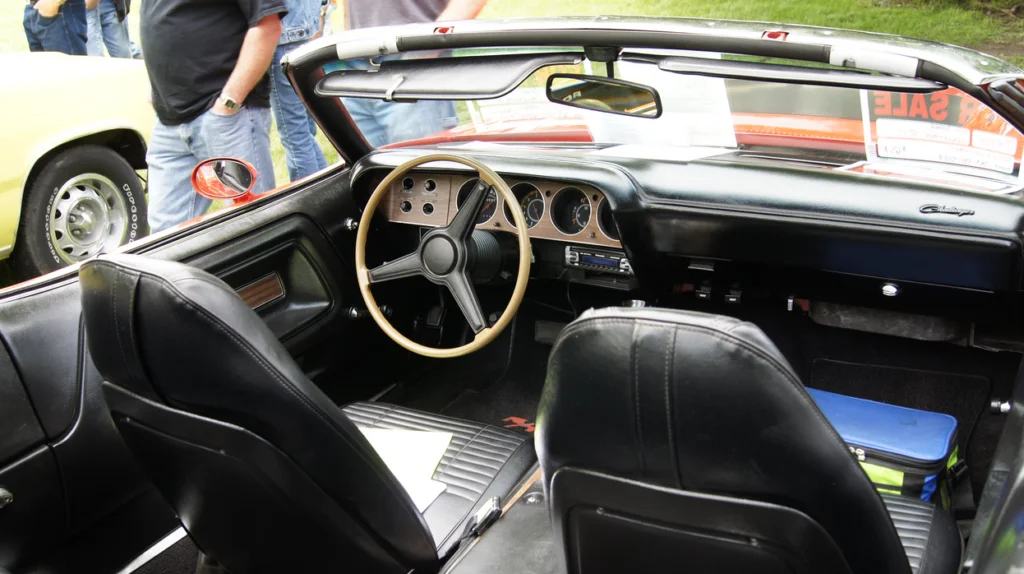
By 1973, the muscle car era was winding down, but Dodge wasn’t going quietly into that good night. The Challenger’s Rallye interior package in black but with understated yet engaging detailing was their last hurrah—quiet highlights against black that looked like a sunset over the Indianapolis Motor Speedway. The muted tan and black theme extended throughout the cabin, creating an environment that was both sporty and surprisingly sophisticated.
This color combination worked because it embraced the changing times while still honoring the Challenger’s performance heritage. The light brown wasn’t the garish shade you might expect; it was more like a rich sandy spice that complemented the car’s aggressive exterior styling. When you added the Rallye dashboard with its full complement of gauges, you had an interior that looked like it belonged in a race car, even if the 340 small block under the hood was more bark than bite compared to earlier years.
8. Corvette with Red Interior
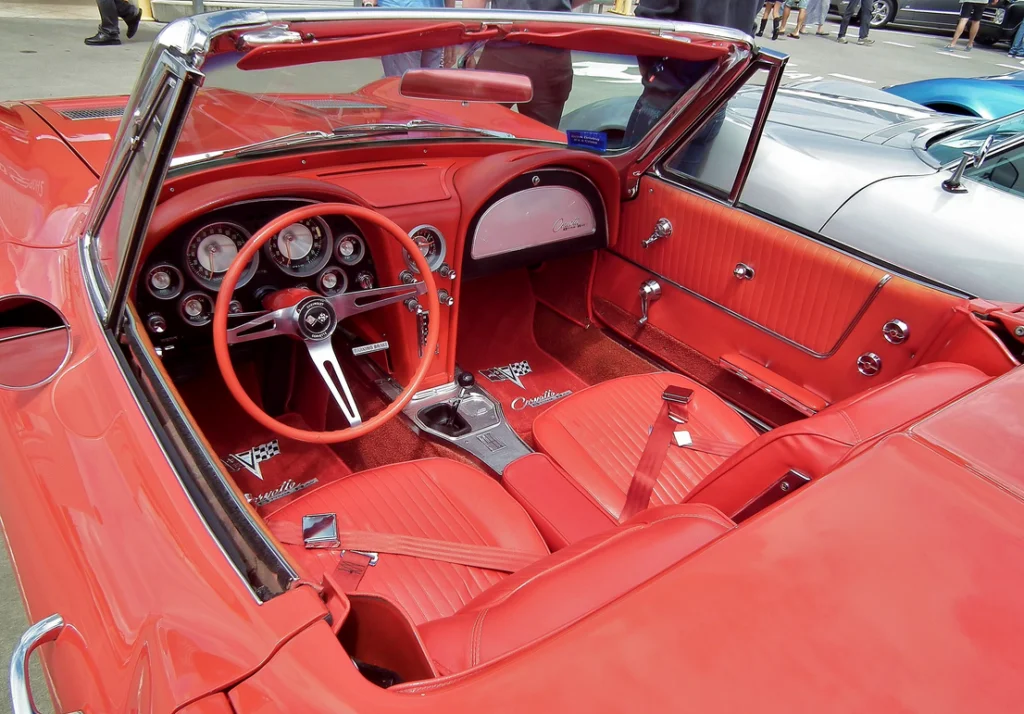
The ’68 Corvette’s all-red interior option was automotive audacity at its finest—bright red vinyl seats, matching door panels, and even red carpeting that made the cabin look like the inside of a Valentine’s Day card. This wasn’t subtle; it was a full-commitment color scheme that announced your arrival long before anyone heard the rumble of the 427 big block. The red interior was available with almost any exterior color, creating some combinations that were either brilliant or bonkers, depending on your perspective.
The red interior succeeded because the Corvette was already a statement car—adding a bold interior just emphasized what everyone already knew about Corvette owners. The bright color actually made the complex dashboard layout easier to read, which was important in a car with enough gauges to fly to the moon. Plus, it photographed beautifully, which mattered when you wanted to document your weekend adventures for posterity.
9. Mustang Boss 351 with Black Interior
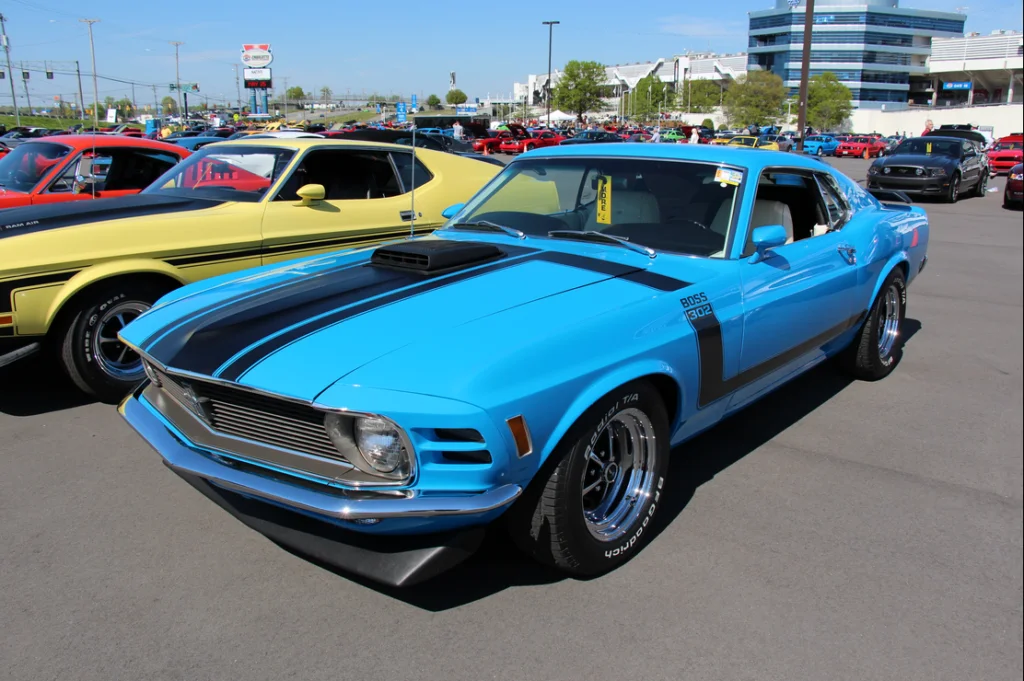
While everyone else was going wild with colors, Ford’s Boss 351 Mustang offered a different kind of sophistication with its all-black interior option. The black vinyl bucket seats featured distinctive pleating that looked like racing seats, while the matching door panels and dashboard created an environment that was all business. This wasn’t the boring black of economy cars; it was the purposeful black of serious performance machinery.
The black interior worked perfectly with the Boss 351’s mission as Ford’s street-and-strip performer. It didn’t distract from the serious business of driving fast, and it made the car’s functional elements—like the competition-style steering wheel and full gauge package—the stars of the show. When you combined it with the Boss’s aggressive exterior graphics and that sweet-revving 351 Cleveland V8, you had a car that looked as serious as it was fast.
10. GTO Judge with Orbit Orange Interior

Pontiac’s GTO Judge was already an attention-getter with its wild graphics and Ram Air engines, but the optional Orbit Orange interior took things to a whole new level. This wasn’t just orange—it was ORANGE, a color so bright it could probably be seen from orbit, hence the name. The orange vinyl covered everything from the bucket seats to the door panels, creating an interior that was impossible to ignore and absolutely perfect for a car called “The Judge.”
The Orbit Orange interior succeeded because it matched the Judge’s extroverted personality perfectly. This was a car that came with “The Judge” decals and a rear spoiler, so subtlety was already off the table. The bright orange actually made the black steering wheel and gauges more prominent, which improved functionality while making a statement that could be heard three counties away.
11. Mercury Cougar
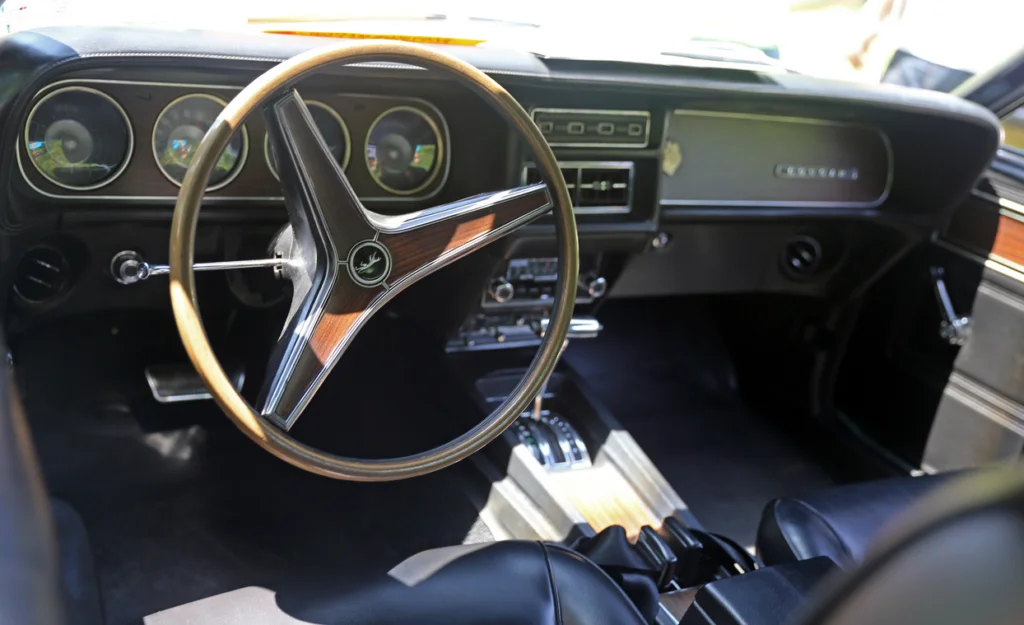
Mercury’s Aqua interior option for the Cougar was like bringing a piece of the night sky into your daily commute. This unique midnight black color covered the vinyl bucket seats and door panels, creating an interior that was both calming and thrilling at the same time. The nighttime theme extended to the dashboard pad, making the Cougar’s cabin feel more like a luxury lounge than a typical pony car interior.
The inky black interior worked because it emphasized the Cougar’s position as the sophisticated alternative to the Mustang. The color was striking enough to be interesting but refined enough that it didn’t overwhelm the car’s elegant interior design. When you added Mercury’s attention to detail—like the sequential taillights and hidden headlights—the Aqua interior helped create a car that was as much about style as it was about performance.
12. Firebird Esprit with Buckskin Interior
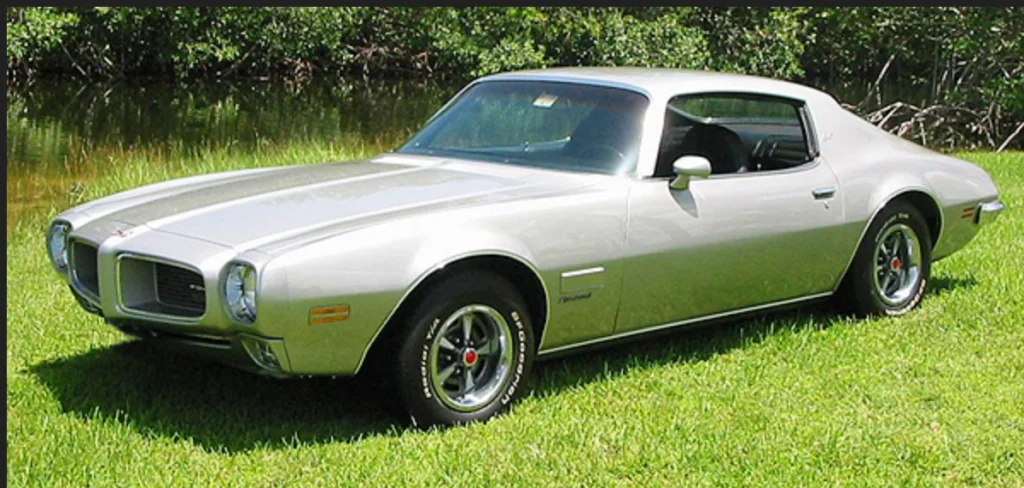
As the muscle car era evolved into the personal luxury era, Pontiac’s Buckskin interior for the Firebird Esprit showed that performance cars could still be stylish without being wild. This warm, tan-colored vinyl created an interior that looked more like a leather lounge than a typical sports car cabin. The color was sophisticated enough for business meetings but casual enough for weekend adventures, making it the perfect choice for the changing times.
The Buckskin interior succeeded because it reflected the Firebird’s evolution from pure muscle car to grand touring machine. The warm tan color made the cabin feel inviting and comfortable, which was important in a car that was increasingly being used for long-distance cruising rather than quarter-mile sprints. It was proof that you could have style and comfort without sacrificing the sporty character that made Firebirds special in the first place.
Those were the days when car designers had the courage to be different and buyers had the confidence to embrace it. Today’s interiors might be more practical and easier to maintain, but they’ll never have the personality and pure joy of those groovy decades when every trip to the grocery store felt like an adventure in style. Maybe it’s time we brought a little more color back into our lives—and our driveways.


